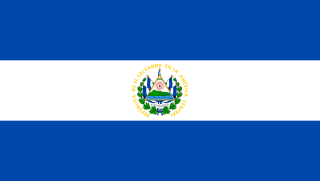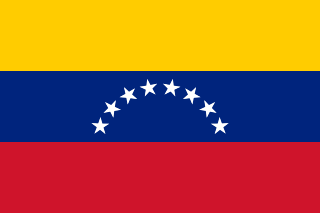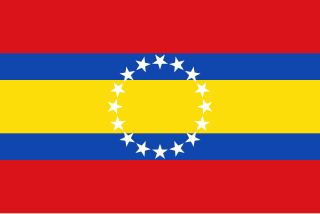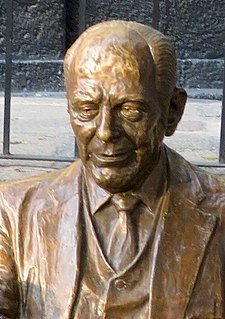This article is being considered for deletion in accordance with Wikipedia's deletion policy. Please share your thoughts on the matter at this article's deletion discussion page. |
This is a list of city flags in Ecuador.
This article is being considered for deletion in accordance with Wikipedia's deletion policy. Please share your thoughts on the matter at this article's deletion discussion page. |
This is a list of city flags in Ecuador.

For the use by the municipalities, a flag with the same colors and proportions as the national flag was adopted, which instead of a shield bears a set of white stars that are placed in a circular pattern on the blue stripe. The number of white stars correspond to the number of provinces in Ecuador. However, this flag is similar to the flag of Venezuela from 1905 to 1930, which contained in its blue stripe a total of 7 stars placed in a circle.

Coamo is a town and municipality founded in 1579 in the south-central region of Puerto Rico, located north of Santa Isabel; south of Orocovis and Barranquitas; east of Villalba and Juana Díaz; and west of Aibonito and Salinas. Coamo is spread over 10 barrios and Coamo Pueblo – the downtown area and the administrative center of the city. It is both a principal city of the Coamo Micropolitan Statistical Area and the Ponce-Yauco-Coamo Combined Statistical Area.

The national flag of Ecuador, which consists of horizontal bands of yellow, blue and red, was first adopted by law in 1835 and later on 26 September 1860. The design of the current flag was finalized in 1900 with the addition of the coat of arms in the center of the flag. Before using the yellow, blue and red tricolor, Ecuador used white and blue flags that contained stars for each province of the country. The design of the flag is very similar to those of Colombia and Venezuela, which are also former constituent territories of Gran Colombia. All three are based on a proposal by Venezuelan General Francisco de Miranda, which was adopted by Venezuela in 1811 and later Gran Colombia with some modifications. There is a variant of the flag that does not contain the coat of arms that is used by the merchant marine. This flag matches Colombia's in every aspect, but Colombia uses a different design when her merchant marine ships are at sail. Along with Haiti, the Dominican Republic and El Salvador, it is one of only four national flags whose design incorporates a depiction of the flag itself.

The flag of El Salvador features a horizontal triband of cobalt blue-white-cobalt blue, with the coat of arms centered and entirely contained within the central white stripe. This design of a triband of blue-white-blue is commonly used among Central American countries. Along with Costa Rica, the Dominican Republic, Ecuador and Haiti, it is one of only six national flags which has a depiction of its flag within the flag itself.

The flag of Honduras consists of three equal horizontal stripes of turquoise, white and turquoise, with five turquoise stars in a quincuncial pattern at the center of the middle stripe. The two outer bands represent the Pacific Ocean and the Caribbean Sea, and also represent the blue sky and brotherhood. The inner band represents the land between the ocean and the sea, the peace and prosperity of its people, and purity of thoughts. The five stars represent the five nations of the former Federal Republic of Central America and the hope that the nations may form a union again.

The current eight stars flag of Venezuela was introduced in 2006. The basic design includes a horizontal tricolour of yellow, blue, and red, dating to the original flag introduced in 1811, in the Venezuelan War of Independence.

Santa Ana de los Cuatro Ríos de Cuenca, commonly referred as Cuenca is the capital and largest city of the Azuay Province of Ecuador. Cuenca is located in the highlands of Ecuador at about 2,560 metres above sea level, with an urban population of approximately 329,928 and 661,685 inhabitants in the larger metropolitan area.

Río Grande is a town and municipality of Puerto Rico located on the eastern edge of the Northern Coastal Valley, north of Las Piedras, Naguabo and Ceiba; east of Loíza and Canóvanas and west of Luquillo. Río Grande is spread over eight barrios and Río Grande Pueblo. It is part of the San Juan-Caguas-Guaynabo Metropolitan Statistical Area. A big portion of El Yunque National Forest, including El Yunque's peak, is located within the municipality.

El Oro is the southernmost of Ecuador's coastal provinces. It was named for its historically important gold production. Today it is one of the world's major exporters of bananas. The capital is Machala.

Loja Province is one of 24 provinces in Ecuador and shares its southern border on the west with El Oro Province, on the north with El Azuay, and on the east with Zamora-Chinchipe. Founded on its present site in 1548 by Captain Alonso de Mercadillo (Spanish), the site had been previously moved and rebuilt from La Toma due to earthquakes. It also is named as "Cuxibamba Valley", from the Quichua language, which means the "Smiley Valley".

Loja, formerly Loxa and fully City of the Immaculate Conception of Loja, is the capital of Ecuador's Loja Province. It is located in the Cuxibamba valley in the south of the country, sharing borders with the provinces of Zamora-Chinchipe and El Oro, and with Peru in the south. Loja holds a rich tradition in the arts, and for this reason is known as the Music and Cultural Capital of Ecuador. The city is home to two major universities.

Manuel Benjamín Carrión Mora was an Ecuadorian writer, diplomat and cultural promoter.
Lieutenant Francisco Gonzalo Marín, also known as Pachín Marín, was a poet and journalist who fought alongside José Martí as a member of the Cuban Liberation Army. He is among those who allegedly designed the Puerto Rican flag.
Banos or Baños may refer to:
The 2012 Campeonato Ecuatoriano de Fútbol de la Serie A was the 54th season of the Serie A, Ecuador's premier football league. The season began on February 3 and ended in December 2012. Deportivo Quito was the defending champion. They were succeeded by Barcelona, who won their record-breaking 14th title.

The flag of Puerto Rico represents and symbolizes Puerto Rico and its people.
The Amazing Race 6 is the sixth season of the Latin American version of the American reality show The Amazing Race. As in seasons prior, the show consisted of 11 teams of different nationalities competing, though for this season the Race took place entirely in Ecuador. The program was broadcast throughout Latin America on cable network Space, and in Ecuador on TC Televisión. The prize for the winning team was US$100,000, which was less than the prize given in previous seasons.
Ecuador is a country with vast natural and cultural wealth. The diversity of its four regions has resulted in hundreds of thousands of species of flora and fauna. It has about 1640 species of birds. The species of butterflies line the 4,500, the 345 reptiles, 358 amphibians and 258 mammals, among others. Ecuador is considered one of the 17 countries where the greatest biodiversity of the planet is concentrated. Most of its flora and fauna live in 26 areas protected by the State. It also offers historical attractions such as Quito, food and a variety of cultures and traditions.
The 2019 Copa Ecuador was the first edition of the Copa Ecuador, Ecuador's domestic football cup. It began with the first round on 10 November 2018 and concluded with its double-legged final on 10 and 16 November 2019. LDU Quito were the winners, beating Delfín on away goals after tying 3–3 on aggregate score. They would have qualified for the 2020 Copa Sudamericana, but since they had already qualified for international competition through their league performance as well as the runners-up and both semifinalists, the berth was reallocated to the ninth-placed team of the league, El Nacional.